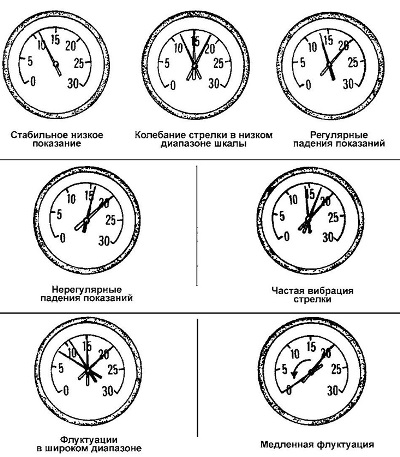
3.1 Variants of indications of the vacuum gauge when diagnosing engine malfunctions
2. Connect the vacuum gauge to the inlet pipeline. Start and warm up the engine to normal operating temperature.
3. Read the vacuum gauge.
If the engine is in normal condition, the gauge readings should be constant and be 430 - 560 mm Hg. Art.
A low, constant reading on the vacuum gauge indicates damaged gaskets between the intake manifold and throttle body, damaged vacuum hose, incorrectly set ignition timing, or incorrectly set valve timing.
If the readings of the vacuum gauge are below the norm by 80-200 mm Hg. Art. and fluctuate, the inlet pipe gasket near the inlet may be damaged or the injector may be defective. If the readings constantly fall by 50-100 mm Hg. Art. relatively stable value, the valves may be damaged. In this case, the compression in the engine cylinders should be measured (see section 2).
If the readings drop, but not regularly, then the valve may be stuck or there is a malfunction in the ignition.
If, at constant idle speed, the readings fluctuate rapidly with an amplitude of about 100 mm Hg. Art., and smoke comes out of the exhaust pipe, the valve guides may be damaged.
If the reading fluctuates rapidly as the idle speed increases, the intake manifold or cylinder head gasket may be damaged, the valve springs are weak, the valves are burnt, or the ignition is misfiring.
Small fluctuations of about 25 mm Hg. Art. usually associated with failures in the ignition system.
If the reading fluctuates greatly, then the cylinder head gasket or cylinder may be damaged.
If the needle moves slowly over a wide range of values, then the controlled crankcase ventilation system may be clogged, the intake pipe gasket or the gasket between the throttle body and the pipeline is damaged.
4. Check how quickly the readings of the vacuum gauge are restored after a sharp and full opening of the throttle valve and its return to its original position. If the engine is in normal condition, the reading drops to near zero, then rises by about 130 mmHg. Art. above normal and again decrease to the previous values at constant idle speed. If the reading recovers slowly and goes through a maximum after closing the throttle, then the piston rings may be damaged. If there is a long delay, then the exhaust system may be clogged.
